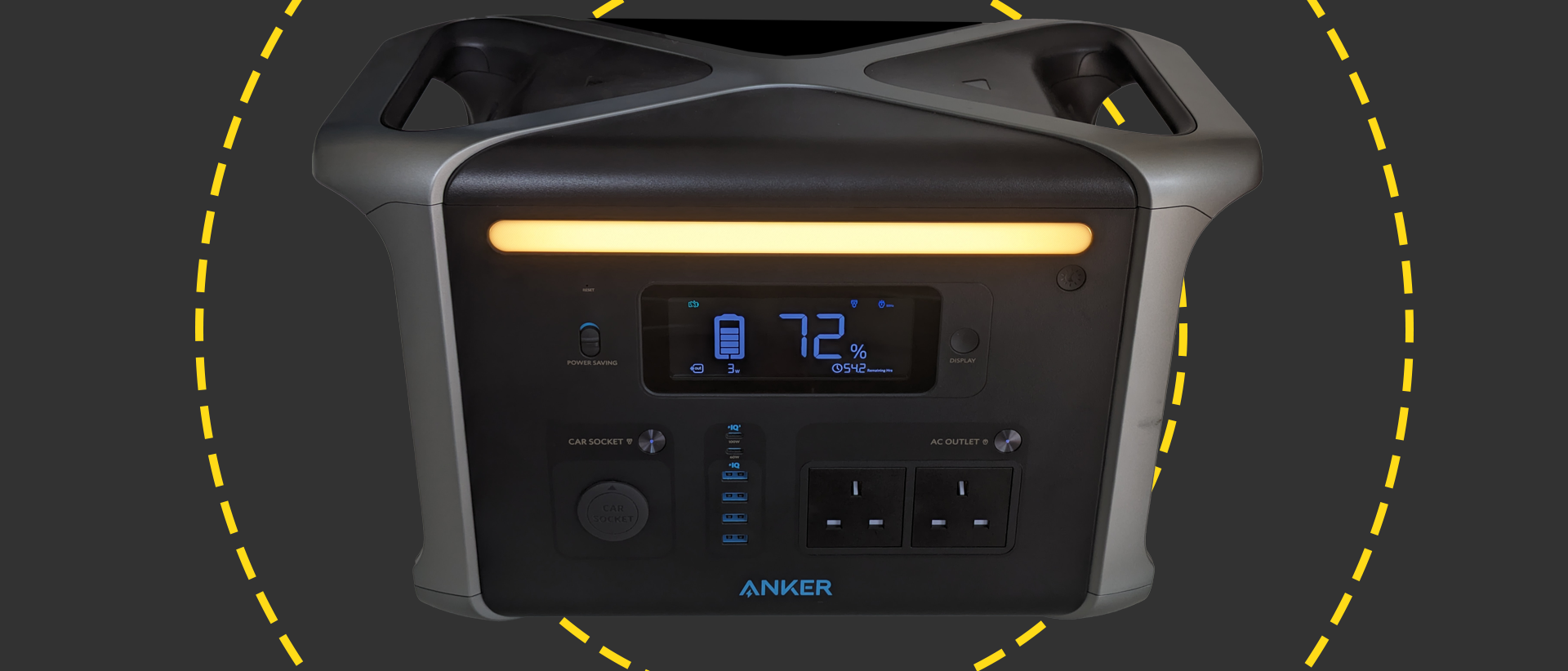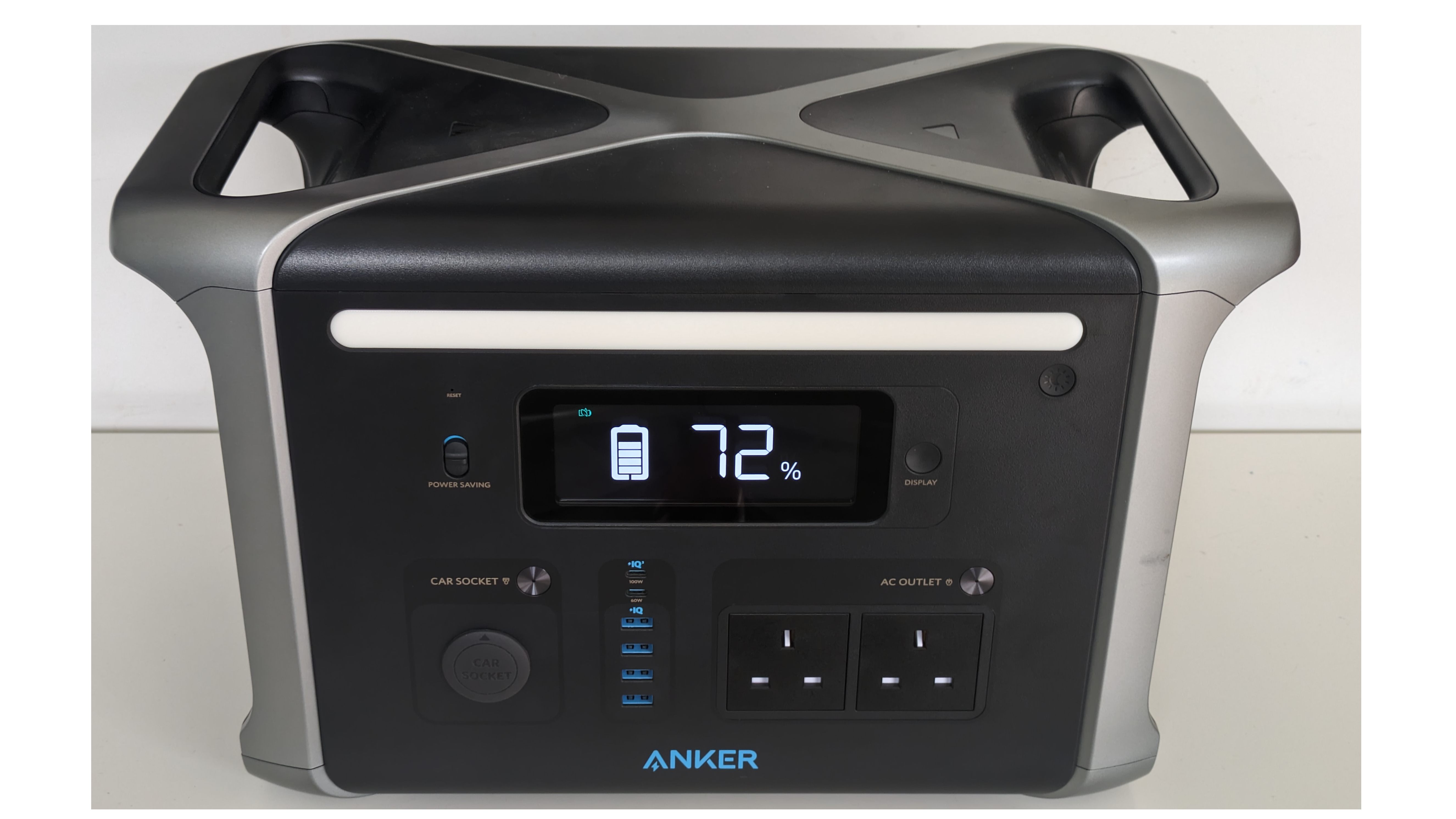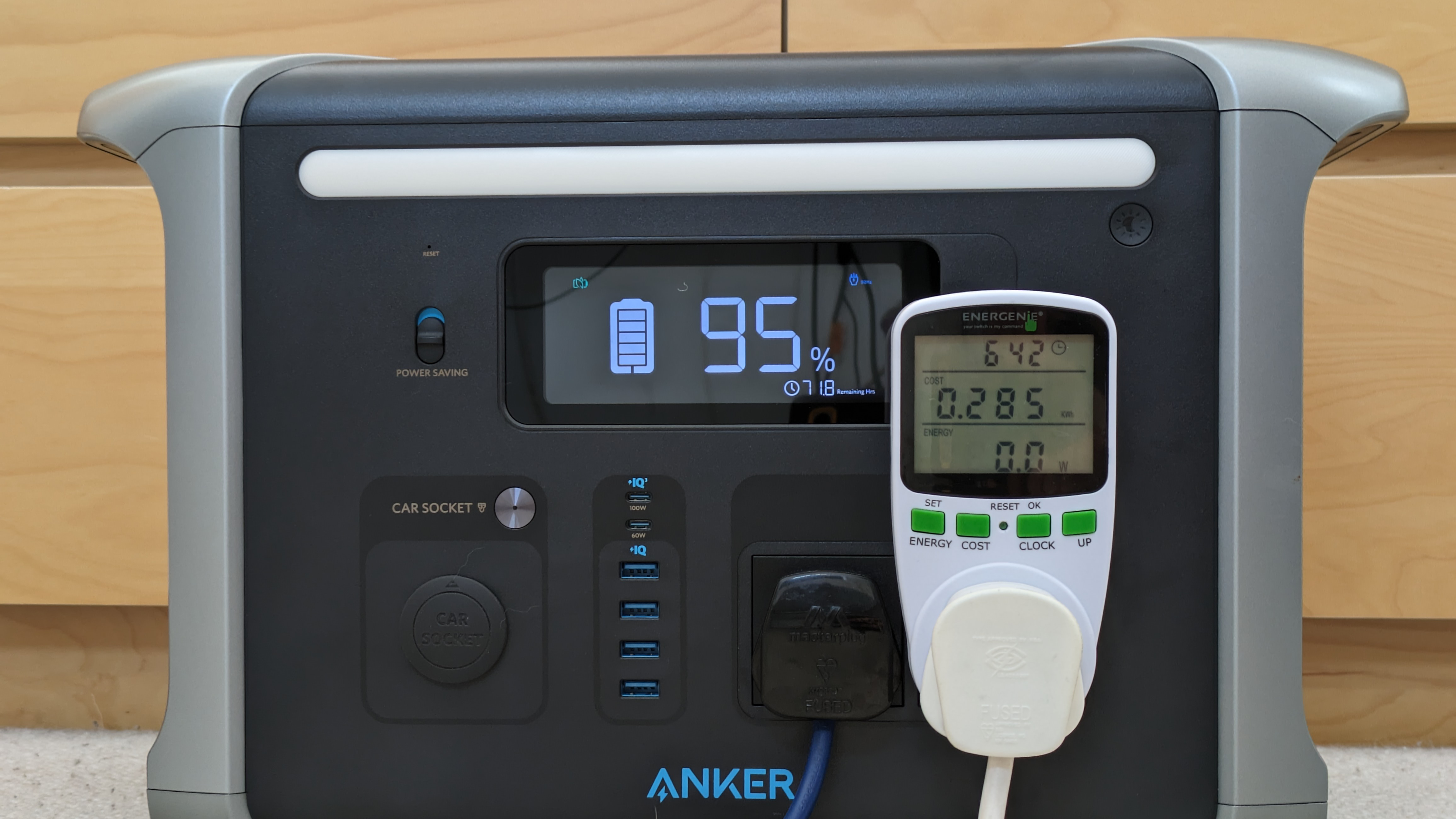Anker SOLIX F1200 review: Powerful backup option for the micro office
The SOLIX F1200 isn't a classic UPS, but it's an incredibly capable backup power supply for the home office

-
+
Excellent features, capacity and power delivery
-
-
Not a classic UPS, so no alarms or power management support

The pandemic may have subsided, but many of us still work from home offices and depend entirely on home services like broadband and power. That's fine when they're working, but they're not subject to the same SLAs as office resources – and even a few minutes off the grid can cause lost work and disruption when you least need it.
Anker's SOLIX F1200 (formerly known as the PowerHouse 757) isn't sold primarily as backup power for an office, but it's capable of filling that role extremely well. It's a brute of a device, filled with lithium iron phosphate (LFP) rechargeable batteries which can store just over 1.2 kilowatt-hours (kWh) of electricity. It's capable of supplying up to 1.5 kilowatts (kW) of AC power, with a further 300 watts (W) across its various other ports. With a typical office PC and monitor combo consuming around 150W, that's enough to power a single worker for almost a full day, or a couple of people in a micro office for perhaps half a day.
Anker SOLIX F1200 review: Design and connections
The SOLIX F1200 is sold primarily as a mobile power source and home backup device, and its features are well chosen for this role. Its front panel has a good range of ports, including a cigarette-type car power socket, but office users will be most interested in its range of AC and USB power options. There are only two UK mains sockets, compared to the 4-8 kettle ports you might find on a well-specified small office UPS, but it's easy to just connect a multi-way adaptor to create more options.
The F1200 offers four USB-A charging ports, each rated for 2.4A (12 watts). There are also two USB-C ports, one rated for 60W and the other for a hefty 100W. These are perfect for fast-charging smartphones or tablets, and even provide enough power to support a typical office laptop.

At the rear you'll find a single kettle-style mains input, along with an XT60 connector for up to 300W of solar panels. You can buy these separately or as part of a bundle, but it's unlikely they'd keep you off grid for an extended period unless you had a fairly minimal office setup. Anker supplies a car adaptor, supporting charging from a cigarette-type car socket at up to 120W. That opens up the possibility of using the F1200 to power a mobile office in a van or camper, but it doesn't have enough storage or output for professional coffee or catering machines.
The main omission from a business perspective is any kind of data link, via USB or Ethernet. The Anker SOLIX F1200 can't communicate with computers to trigger an orderly shutdown. There's also no audible alarm to warn you as its battery nears empty. For this reason, it's not suited for a true UPS role, particularly if paired with an unattended server or other sensitive equipment.
Anker says that the SOLIX F1200 has a drop-proof design, and it certainly feels extremely strong and well-made. The two large handles make it relatively easy to hold, but at 20.1kg it's not something you'd want to carry up too many stairs. Underneath, two large rubber feet help stop it sliding about, and there are large cooling vents at either end – assisted by fans when needed.
This power bank has a large display, showing battery power as a percentage, along with the total outgoing and incoming power. There's also an indicator of how long the battery will take to recharge or discharge, depending on what's connected and whether mains is available.
Anker SOLIX F1200 review: Battery and power capabilities
The F1200 is filled with LFP batteries, similar to those used in electric vehicles. These offer a much greater lifespan than standard lithium-ion, being rated for 3,000 charge cycles rather than the 800-cycle design life of cheaper power packs. Anker says this power supply is designed for 10 years of daily use, and it comes with a strong five-year warranty that includes the battery.
While this isn't replaceable, it offers greater power density and much longer life than the sealed lead-acid units found in most small uninterruptible power supplies. Weight for weight, it's roughly equivalent to a 200vAh lead-acid device, yet it stores about six times as much power. It's also much quicker to charge.

Connected to the mains, the F1200 can charge at up to 1kW, getting from empty to 80% in just one hour. There's also a bypass function, allowing it to power mains devices without the inefficiency of first converting to direct current, then back to AC. This also means it can continue to charge at its full rate even when supplying its rated AC output. In a power cut, switching to battery power takes less than 20 milliseconds. That's not as fast as a purpose-designed UPS, which might switch in well under 10ms, but it was quick enough to prevent issues with the NAS and computers we tested.
The final advantage of using LFP batteries is that they offer a far greater peak power output. The F1200 can output a maximum of 1.8kW across all its ports, including 1.5kW of AC power – although that total is shared across both mains sockets. Anker says that's enough to power 95% of devices. It's certainly enough for almost anything except washing machines, kettles or vented tumble driers, and comfortably enough for the things you'll find in a small office.
Anker SOLIX F1200 review: Performance
We tested the SOLIX F1200 on a home office setup comprising two laptops, a desktop, and a large ultra-wide monitor, along with a gigabit Ethernet switch, an LED desk light, a NAS and a colour laser multifunction peripheral (MFP). Together this constituted a base load of around 200-300 watts, with a peak (during printer warm up) of nearer the 1.5kW maximum.
Whether receiving mains power, working from battery or repeatedly switching between the two, the power bank was unruffled. Power delivery was uninterrupted, and no devices crashed or flickered. During charging, and when supplying a small to moderate load, there was just the slightest trace of fan noise. When printing this became quite loud, but not especially harsh, and the fans slowed down again within about five seconds of the load dropping off.
We tested the SOLIX F1200's low-load efficiency by connecting it, via a mains power meter, to an air purifier using a constant 33 watts. Its battery lasted for almost a day, and we measured the total power supplied at 644 watt-hours (Wh). Assuming the battery went from fully charged to fully empty, that's a discharge efficiency of just 52.4%. We repeated the test to power a large fridge/freezer with a more variable load averaging out at 40-50W. Here the F1200 lasted 18 hours, delivering 672Wh for an efficiency of 54.6%.
While that sounds poor, it's actually about typical for this class of device, with much of the missing power lost to the overheads of running an AC inverter for several hours. That's why the F1200 has a power-saving mode which, when enabled, switches off its AC sockets after a few minutes of minimal loading. If you're using it for low-power medical equipment such as a CPAP machine, it's advisable to switch this off.
This power bank really excelled when connected to heavier loads. We used it with various high-power kitchen gadgets over a day or so. It didn't flinch when supplying 1.1kW to a toaster or 1.3kW to a microwave.
Although we don't recommend it, we also used the F1200 to power a 1.8kW kettle – fully 20% beyond its maximum output rating - while we boiled two full loads of water back to back. That's an unreasonably demanding test, but it remained completely comfortable. Our power meter confirmed it was supplying a sustained 1,518W at 225 volts, limiting the current to about 6.8 amps.
When we finally exhausted the battery with these heavy-duty tests, the F1200 had supplied a total of 949Wh, a more impressive discharge efficiency of 77.2%.
This power bank is quite efficient when charging. When fully empty it spent a few minutes drawing an indicated 250W before stepping up to an indicated 999W, which corresponded to 1,093W on our power meter. When fully charged this said it had consumed 1.36kWh which, assuming the battery went from fully empty to completely full, is equivalent to 90% efficiency.
Using our best charge and discharge figures, we calculated a round-trip efficiency of just under 70%, meaning that about 30% of the AC power supplied to the F1200 was lost – that's not bad for a power bank. Some of this loss is unavoidable, but as mentioned, a portion will be down to the inverter – you'll get greater efficiency if you can power devices only using the USB ports, which supply direct current.
Anker SOLIX F1200 review: Is it worth it?
The Anker SOLIX F1200 offers greater battery capacity, faster charging, and a higher peak output than a typical small office UPS. However, its advanced batteries make it more expensive. More importantly, without a comms link or an audible warning, it's not ideally suited to use as a classic UPS. And while its sub-20ms switching time was fine with our equipment, it might not be fast enough for more sensitive, mission-critical devices.
That said, the F1200 is well suited to providing short to medium-term backup power in a small home office, even if there's more than one user. Its USB ports should amply cover mobile devices, while its high AC output means it can cope with computers, and even keep a laser printer going. How long it would last depends on the load, but as part of our tests we used its USB ports to recharge and power a single Chromebook and mobile phone for more than a week.
While it's a more niche application, the F1200 is also suitable to power a mobile office in a car, van, or even a tent. Using the optional solar panels or supplied car charger, it could potentially even do this indefinitely, depending on the load, weather, and how long the drive is between sites.
Overall this is a solid and dependable power supply, offering a good range of ports and functions. It doesn't belong in the server room, but it could prove invaluable if your home or small office is prone to power cuts.
Anker SOLIX F1200 specifications
| Technology | Lithium iron phosphate (LFP) rechargeable battery |
| Battery | 1,226Wh |
| Maximum output | AC 1,500W DC 300W (1,800W max) |
| Dimensions (HXWXD) | 463x288x237mm |
| Weight | 20.1kg |
| Warranty | Five years |
| Details | www.anker.com/uk |
| Part code | A1770 |
Get the ITPro daily newsletter
Sign up today and you will receive a free copy of our Future Focus 2025 report - the leading guidance on AI, cybersecurity and other IT challenges as per 700+ senior executives
After a brief career in corporate IT, Simon Handby combined his love of technology and writing when he made the move to Computer Shopper magazine. As a technology reviewer he's since tested everything from routers and switches, to smart air fryers and doorbells, and covered technology such as EVs, TVs, solar power and the singularity.
During more than 15 years as Shopper's long-time printer reviewer, Simon tried, tested and wrote up literally hundreds of home, small office and workgroup printers. He continues reviewing smart products and printers for a variety of publications, and has been an IT Pro contributor since 2010. Simon is almost never happier than when surrounded by printers and paper, applying his stopwatch and a seasoned eye to find the best performing, best value products for business users.
-
 ‘Phishing kits are a force multiplier': Cheap cyber crime kits can be bought on the dark web for less than $25 – and experts warn it’s lowering the barrier of entry for amateur hackers
‘Phishing kits are a force multiplier': Cheap cyber crime kits can be bought on the dark web for less than $25 – and experts warn it’s lowering the barrier of entry for amateur hackersNews Research from NordVPN shows phishing kits are now widely available on the dark web and via messaging apps like Telegram, and are often selling for less than $25.
By Emma Woollacott Published
-
 Redis unveils new tools for developers working on AI applications
Redis unveils new tools for developers working on AI applicationsNews Redis has announced new tools aimed at making it easier for AI developers to build applications and optimize large language model (LLM) outputs.
By Ross Kelly Published
-
 Google layoffs continue with "hundreds" cut from Chrome, Android, and Pixel teams
Google layoffs continue with "hundreds" cut from Chrome, Android, and Pixel teamsNews The tech giant's efficiency drive enters a third year with devices teams the latest target
By Bobby Hellard Published